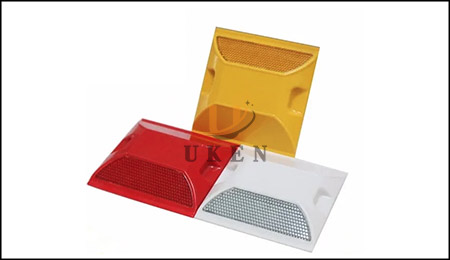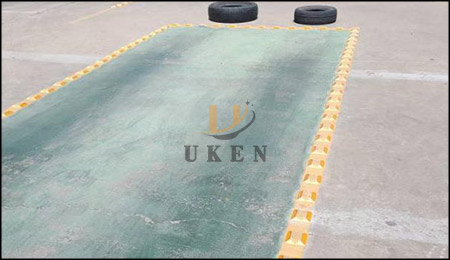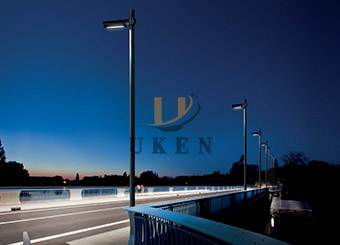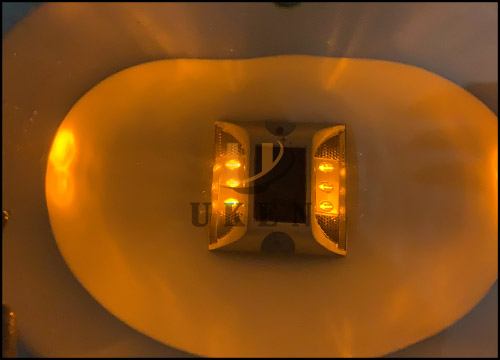Driving schools serve as the cradle of driver training, marking the starting point for learners to master driving skills. Training safety not only directly impacts learners’ learning outcomes but also plays a crucial role in fostering good driving habits for the future. In driving school training areas, clear road markings and comprehensive safety facilities are key to reducing training accident rates. Statistics show that a well-regulated training environment can reduce learner operational error rates by over 30%, effectively ensuring learner safety and the smooth progression of training.
Plastic reflective road studs, as important safety facilities in driving school training areas, offer outstanding reflective performance and stable physical properties, significantly enhancing the safety and standardisation of the training environment. This article will delve into the specific applications, unique advantages, and practical effects of plastic reflective road studs in driving school training, providing reference for upgrading driving school safety facilities.

Plastic reflective road studs are made of high-strength engineering plastic shells, which possess exceptional impact resistance and wear resistance. Even under frequent vehicle Rolling, they can maintain structural integrity. Their core optical reflective components are equipped with high-quality reflective sheets or films. When light is incident, they utilise the principle of total internal reflection to reflect light back to the light source with high brightness, creating a prominent visual effect.
Compared to metal markers, plastic reflective road studs are lighter in weight, allowing a single person to handle transportation and installation, significantly reducing construction difficulty and labour costs. Additionally, metal road studs are prone to rusting over time, which affects their reflective performance and service life. Plastic road studs do not have this issue. Compared to rubber road studs, plastic road studs have higher hardness, are less prone to deformation at high temperatures, and have strong resistance to ageing. Under normal usage conditions, their service life can reach 5–8 years, with maintenance costs amounting to approximately 40% of those for rubber road studs.
Plastic reflective road studs come in a variety of colours, including red, yellow, white, and blue. Driving schools can use different coloured studs to mark functional zones based on training needs. For example, red studs can be used for hazard warnings, yellow studs for speed reduction zones, and white studs to clearly define lane boundaries. Additionally, their excellent weather resistance allows them to adapt to various climatic conditions, maintaining high reflective performance under extreme heat, cold, or heavy rain.
In driving school training areas, plastic reflective road studs are arranged in a regular pattern to clearly outline lane boundaries. During driving, trainees can intuitively follow the road stud markings to maintain the correct driving trajectory. Especially at night or in foggy, rainy, or other low-light conditions, the bright light reflected by the studs effectively reinforces lane boundaries, preventing learners from veering off course due to poor visibility and reducing the risk of nighttime training accidents by approximately 40%.
Driving schools can use plastic reflective road studs of different colours and arrangements to simulate real-world traffic signs and markings. For example, white road studs can be arranged in a zebra pattern to simulate a pedestrian crossing, yellow road studs can be spaced out to simulate speed bumps, and red road studs can be arranged in a circle to simulate no-parking zones. This simulated training method allows learners to familiarise themselves with various road signs in advance, quickly adapt to real-world road environments, improve learning efficiency, and increase the pass rate in subject exams by over 25%.
In hazardous areas such as sharp turns, steep slopes, and obstacles within driving school training zones, plastic reflective road studs play a powerful warning role. Their high-brightness reflective light acts as a prominent ‘safety signal light,’ reminding learners to slow down in advance, operate cautiously, and prepare for potential hazards. According to actual case statistics, in hazardous areas equipped with plastic reflective road stud warnings, the incidence of training-related accidents has decreased by 50%.
For driving school instructors, the clear markings of plastic reflective road studs facilitate teaching. When guiding students in parking positioning, reverse parking, and other exercises, instructors can use the studs to accurately point out operational deviations, making teaching more targeted. During student assessments, the clear markings of the studs also provide examiners with objective evaluation criteria, ensuring the fairness and accuracy of assessment results.

Before the renovation, a large driving school faced issues such as unclear lane markings and a lack of warnings in hazardous areas, leading to frequent accidents like scrapes and collisions, with an annual accident rate as high as 12%. After introducing plastic reflective road studs, the driving school reorganised the training area: white studs clearly demarcated lanes, red studs marked sharp turns and obstacle zones, and yellow studs indicated speed reduction zones. After the renovation, the accident rate among trainees dropped sharply to 7%, with a significant improvement in training efficiency and an average reduction of 15% in the training cycle.
A newly established driving school incorporated plastic reflective road studs into its overall design during the planning phase. Based on the requirements of different training projects, the studs were strategically laid out: white studs were used to precisely mark parking points in the reverse parking area, and yellow studs were used to guide driving trajectories on curved sections. After actual use, trainee satisfaction with the training environment reached 95%, with most trainees reporting faster mastery of driving skills and a 20% acceleration in learning progress compared to traditional training methods.
When selecting plastic reflective road studs, driving schools must ensure the products comply with national standards. Key points to check include the reflective performance test reports; qualified road studs should have a reflective distance of at least 300 metres at night. Additionally, pay attention to the compressive strength indicators, which must withstand at least 20 tonnes of pressure testing. Furthermore, based on factors such as the scale of the training area and vehicle usage frequency, driving schools should reasonably select the specifications and quantity of road studs to avoid insufficient quantities affecting the marking effectiveness.
Before installation, thoroughly clean the ground to ensure it is flat and free of debris. For cement surfaces, use epoxy resin adhesive for bonding; for asphalt surfaces, use hot melt adhesive for fixation. During installation, strictly ensure that the road studs are arranged neatly, with consistent height, and that the spacing error between adjacent road studs is controlled within ±1 centimetre to ensure the continuity of reflective performance and operational stability.
During routine maintenance, the reflective surfaces of the studs should be cleaned regularly using a soft cloth or brush to remove dust, dirt, and other contaminants, maintaining optimal reflective performance. Weekly inspections should be conducted to check for loose or damaged studs, with any issues addressed promptly through reinforcement or replacement. Timely replacement of damaged studs is critical for maintaining the integrity and effectiveness of training area markings, effectively preventing safety hazards caused by missing markings.
Plastic reflective road studs play an irreplaceable role in driving school training areas due to their unique product characteristics and diverse functions. They not only significantly enhance training safety and standardise training processes but also demonstrate strong advantages in auxiliary teaching and assessment, providing strong support for driving schools to improve teaching quality and reduce operational risks. To ensure trainee safety and enhance driving school competitiveness, it is recommended that driving school managers prioritise the construction of safety facilities in training areas and actively consider introducing plastic reflective road studs to optimise the training environment.





